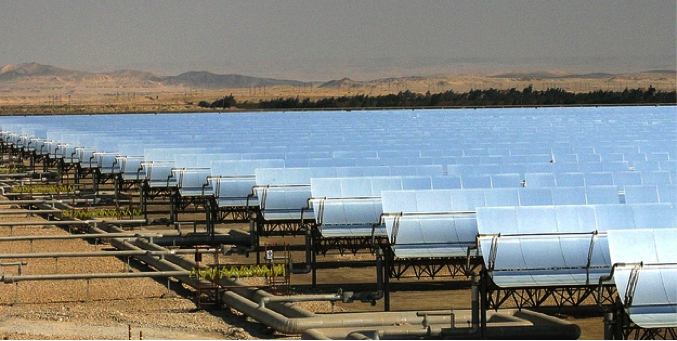Parabolic trough technology is the most widespread among utility-scale solar thermal plants. The potential of this type of concentrating collectors is very high and can provide output fluid temperatures in the range up to 500°C. Parabolic trough is the linear-focus collector, which consists of a cylindrically curved parabolic mirror, which reflects the sunlight onto a tubular receiver positioned in the focus line of the parabola. The tubular receiver contains the fluid that absorbs heat and transfers it via circulation to the boiler or another device to produce steam.

Rows of parabolic mirrors are mounted in parallel on either a north-south axis (typical) or an east-west axis (there are pros and cons to each orientation based on location and energy production requirements) and move to track the sun across the sky. The tubes are very carefully designed to absorb solar radiation and transfer the heat to the heat exchange fluid passing through the tube. Fluid is pumped through the absorber tubes that are connected in series and parallel. Some systems employ an insulated storage tank to enable power generation when the solar resource is either intermittent (due to something like cloud cover) or unavailable (typically during the early evening hours). The heat transfer fluid is then passed through the storage tank, if it exists, and then pumped to heat exchangers to transfer the heat to water (except in the case of direct steam generation where water is already the heat transfer fluid and a heat exchanger is not needed) to generate steam for expansion in a steam turbine to generate electricity.
Solar Energy Generating Systems (SEGS) is the name of the world’s largest parabolic trough solar thermal electricity generation system, developed by Luz in southern California, USA. SEGS is the second largest solar thermal power plant in the world at 354 MW (surpassed by the 377MW Ivanpah Solar Power Tower system discussed in the next section). The three largest plants in the world currently range in size from 250 MW to 354 MW and are all located in the US. The next twelve largest plants in the world range in size from 100 MW to 200 MW and are all located in Spain.
Reading Assignment
Zarza Moya, E. Parabolic-Trough Concentrating Solar Power (CSP) Systems, Chapter 7 in Concentrating Solar Power Technology. Principles, Developments, and Applications., Lovegrove K., and Stein W., Eds., Woodhead Publishing, 2012. pp. 197-237. (This reading material is available in Canvas e-reserve Module 10).
Duffie, J.A., and Beckman, W.A., Solar Engineering of Thermal Processes, Wiley and Sons, 2013, Chapter 17, Section 17.3 (5 pages).
